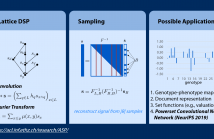- Signal and System Modeling, Representation and Estimation
- Multirate Signal Processing
- Sampling and Reconstruction
- Nonlinear Systems and Signal Processing
- Filter Design
- Adaptive Signal Processing
- Statistical Signal Processing

- Read more about Blind Source Separation of Graph Signals
- Log in to post comments
- Categories:
 22 Views
22 Views
- Categories:
 23 Views
23 Views
- Read more about A Novelty in Blahut-Arimoto Type Algorithms: Optimal Control over Noisy Communication Channels
- 1 comment
- Log in to post comments
A probability-theoretic problem under information
constraints for the concept of optimal control over a noisymemoryless channel is considered. For our Observer-Controller
block, i.e., the lossy joint-source-channel-coding (JSCC) scheme,
after providing the relative mathematical expressions, we propose a Blahut-Arimoto-type algorithm − which is, to the best
of our knowledge, for the first time. The algorithm efficiently finds the probability-mass-functions (PMFs) required for .....................
Comsoc.pdf
- Categories:
 41 Views
41 Views
- Read more about Sampling Signals on Meet/Join Lattices
- Log in to post comments
We present a novel sampling theorem, and prototypical applications, for Fourier-sparse lattice signals, i.e., data indexed by a finite semi-lattice. A semilattice is a partially ordered set endowed with a meet (or join) operation that returns the greatest lower bound (smallest upper bound) of two elements. Semilattices can be viewed as a special class of directed graphs with a strictly triangular adjacency matrix , which thus cannot be diagonalized.
- Categories:
 101 Views
101 Views
- Read more about ACCELERATING NONNEGATIVE MATRIX FACTORIZATION OVER POLYNOMIAL SIGNALS WITH FASTER PROJECTIONS
- Log in to post comments
- Categories:
 21 Views
21 Views
- Read more about Computing Vessel Velocity from Single Perspective Projection Images
- Log in to post comments
We present an image-based approach to estimate the velocity of moving vessels from their traces on the water surface. Vessels moving at constant heading and speed display a familiar V-shaped pattern which only differs from one to another by the wavelength of their transverse and divergent components. Such wavelength is related to vessel velocity. We use planar homography and natural constraints on the geometry of ships’ wake crests to compute vessel velocity from single optical images acquired by conventional cameras.
- Categories:
 40 Views
40 Views
- Read more about PERFORMANCE ANALYSIS OF DISCRETE-VALUED VECTOR RECONSTRUCTION BASED ON BOX-CONSTRAINED SUM OF L1 REGULARIZERS
- Log in to post comments
In this paper, we analyze the asymptotic performance of a convex optimization-based discrete-valued vector reconstruction from linear measurements. We firstly propose a box-constrained version of the conventional sum of absolute values (SOAV) optimization, which uses a weighted sum of L1 regularizers as a regularizer for the discrete-valued vector. We then derive the asymptotic symbol error rate (SER) performance of the box-constrained SOAV (Box-SOAV) optimization theoretically by using convex Gaussian min-max theorem.
- Categories:
 328 Views
328 Views
- Read more about Robust least squares estimation of graph signals
- Log in to post comments
Recovering a graph signal from samples is a central problem in graph signal processing. Least mean squares (LMS) method for graph signal estimation is computationally efficient adaptive method. In this paper, we introduce a technique to robustify LMS with respect to mismatches in the presumed graph topology. It builds on the fact that graph LMS converges faster when the graph topology is specified correctly. We consider two measures of convergence speed, based on which we develop randomized greedy algorithms for robust interpolation of graph signals.
- Categories:
 89 Views
89 Views
Community detection from graphs has many applications
in machine learning, biological and social sciences. While
there is a broad spectrum of literature based on various
approaches, recently there has been a significant focus on
inference algorithms for statistical models of community
structure. These algorithms strive to solve an inference
problem based on a generative model of the network. Recent
advances in stochastic gradient MCMC have played a crucial
role in improving the scalability of these techniques. In this
- Categories:
 4 Views
4 Views
- Read more about POTENTIAL GAMES FOR DISTRIBUTED PARAMETER ESTIMATION IN NETWORKS WITH AMBIGUOUS MEASUREMENTS
- Log in to post comments
Distributed estimation of a parameter vector in a network of sensor nodes with ambiguous measurements is considered. The ambiguities are modelled by following a set-theoretic approach, that leads to each sensor employing a non-convex constraint set on the parameter vector. Consensus can be used to reach an estimate consistent with the measurements of all nodes, assuming that such an estimate exists, but unfortunately, such an approach leads to a non-convex problem.
- Categories:
 3 Views
3 Views